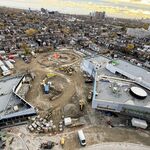Seems to me, our expectations may be getting a bit overthought, given the long period of anticipation. Once the line goes in service, we will have real data to work from instead of the theoretical. Maybe we need to see how it works out.
For what it's worth, I have been driving Eglinton East a few times recently while the test trains have been operating, and I have taken note of who passes who. The testing seems to be simulating realistic station dwell and track speed, so I figure it's a reasonable preview
-The LRT is clearly faster than the existing bus service, and that in itself may benefit riders. Removing those buses may even improve driving times as the bus halts are what impedes the right lane traffic in both directions.
- In average midday traffic, the LRT does seem to move faster than autos, moreso eastward than westward.
- There are still a couple of construction-related lane restrictions (I suspect there will always be, for one thing or another) - and these throttle auto traffic, so the LRT may be a tortoise but it wins in the end..
The point being, maybe speed does not have to be optimal..... so long as it is better than driving, people will find it attractive.
The other things that I have observed are
- Frankly, Eglinton East is a junky street and no form of transit is going to change that. Even where new development is happening, the streetform is sterile and remains autocentric, even where new buildings are going up. Walkable it ain't, nothing to see here. Won't be heading up here to visit a restaurant or go for a stroll. This line will mostly thrive on riders riding through or transferring at major north south routes. It's a transportation corridor rather than an avenue in the making.
- Try to find parking, except at the Golden Mile. Backstreets are signed No Parking and commercial lots all have signs saying "For customers only".
- There are insufficient places to cross Eglinton on foot, and the LRT guideway does not make provision for pedestrians to stand or cross safely. Even the refuge islands at crossings marked two-stage are minimal in size. The grassy row does invite standing or crossing in proximity to the track - I wonder if we should be more concerned about this. LRV priority at major intersections may be less of a concern - should more pedestrian crossings be built, LRV's will need to yield at other points. The design as is will only work because the non-walkable environment means pedestrians will be scarce.
In short, the contribution of the LRT to the built form of the street is not positive and will not stimulate a more vibrant community. I can't build much enthusiasm for this line's form, it is purely functional. Maybe we should have buried this thing after all.
- Paul




